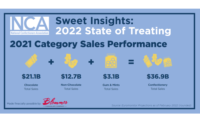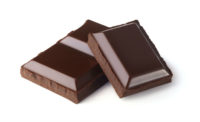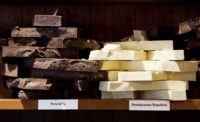North American confectionery market projected to reach $58B by 2023
ResearchAndMarkets.com report shows chocolate is propelling demand for candy.

The North American confectionery market is expected to reach $58 billion by 2023.
That’s according to a new report from ResearchAndMarkets.com, "North America Confectionery Market - Segmented by Product Type, Distribution Channel and Geography - Growth, Trends, and Forecast (2018 - 2023).”
Some of that growth is due to acquisitions, partnerships and new product launches from key players, including Nestlé, Hershey, Ferrero, Mars Inc., and Mondelez International. For example, Ferrero acquired Nestlé’s U.S. brands in early 2018. Nestlé, in partnership with Barry Callebaut, also plans to launch Ruby chocolate in the United States, which is the first new natural color chocolate after white chocolate introduced by Nestlé 80 years ago. This chocolate is made from naturally pink cocoa beans.
The United States is by far the largest confectionery market, accounting for more than 75 percent of the confectionery volume share. But increased demand for higher quality cocoa products and premium chocolate accelerated confectionery sales across North America. In fact, chocolate dominates the market, as demand for cocoa products increases.
Chocolate craving dominates
North American chocolate confectionery volume surpassed 1.6 billion kilograms in 2017, with moulded chocolate leading the segment.
Specifically, moulded chocolate holds 33 percent of the chocolate volume share, which is followed by countlines and softlines. Countlines is the most consumed chocolate in the region, growing at a steady rate of 3 percent. The demand for countlines crossed $8 billion in 2017, driven by on-the-go and convenient pack style of products.
Sales of boxed assortments are also growing in North America, due to seasonal chocolate gifting trends, a demand for premium chocolate and attractive packaging.
However, government regulation regarding sugar tax and promotion activity for sharing bags are also negatively affecting confectionery market growth.
Organic in demand
Consumer interest in organic chocolate is growing in North America as well.
However, organic chocolate still represents a small share in the market, but consumer awareness about the sourcing of raw materials is propelling growth.
The U.S. remains the most significant market for organic confectionery sales. And about 15 percent of U.S. chocolate buyers purchase organic chocolate despite its premium price.
Globally, the organic chocolate market was valued at $732 million in 2012, which reordered a steady growth rate. And chocolates launched with an organic claim increased 6 percent between 2014-2016.
Clean label claim products such as all-natural and preservative-free also are driving the chocolate market in North America.
Looking for a reprint of this article?
From high-res PDFs to custom plaques, order your copy today!







